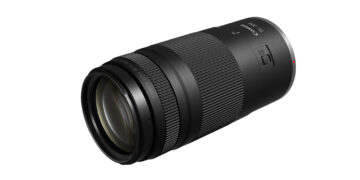Cine Gear 2025 / Vol.04

The main exhibits at the Canon booth at Cine Gear 2025 were the EOS C400 and EOS C80. The EOS C80, which was released in November 2024, made its first appearance at Cine Gear LA Expo. There was also a hands-on exhibit of the new firmware for the EOS C400/C800, which was announced on June 5, 2025. Visitors were able to experience the contents of this firmware update on the actual equipment before it is released to the public in late July.
This update has already been released by Canon USA, and they have posted a promotional video on YouTube, but some regions, such as Japan, have not yet officially announced it. According to Canon USA, the update is scheduled to be released to the public in late July 2025 in the United States.

Enhanced camera display and improved virtual production support
One of the major features of this firmware update is the enhanced display of “DISP Level 2” in camera mode for the EOS C400 and EOS C80. The screen display has been updated to show more information at a glance, such as the sensor mode and resolution, the recording codec selected for each card slot, custom picture, gamma, color space, and the tilt of the electronic level. This makes it possible to consolidate and display almost all information on the screen, which is the main element of this update.

Another major update is that both cameras now support multicast for the CV protocol for virtual production, which allows sending data such as lens metadata from a single camera to multiple PCs.

Canon’s Virtual Production System communicates and calculates the shooting information of the lens and camera in real time, and has the function of acquiring and recording CV metadata suitable for virtual production via a single Ethernet cable. The CV protocol itself has been supported by the EOS C400 since its release, and it is expected to be used even more in the future.
New functions to improve efficiency on set
Other updates include a firmware update for the EOS C400 and EOS C80 that corrects distortion and chromatic aberration when playing back Cinema RAW Light clips in-camera, allowing production teams to accurately review footage on set without having to transfer media to a computer.
These cameras also increase the number of Look/LUT files that can be registered from 20 to 256, and add the ability to pause Digital IS (image stabilization) while recording.
The EOS C400 now offers the ability to combine tracking AF and manual focus: even when tracking AF is active, you can still manually adjust focus using the lens focus ring, and once manual focus is complete the camera will maintain focus and tracking AF will automatically resume.
Demonstration of three-stage BaseISO setting technology
At Canon at Cine Gear 2025 booth, a demonstration of Canon’s unique “3-level BaseISO setting” also attracted attention. This technology is only compatible with the EOS C400 and EOS C80, which are equipped with back-illuminated stacked 6K full-frame sensors.


In the demonstration, a comparison was made between base ISO 800 and base ISO 12800. The shooting conditions were set in an extremely dark environment with an ND6-stop filter and F16, but with base ISO 12800, noise was barely noticeable even at ISO sensitivity 6400, and the low-noise performance was outstanding compared to the base ISO 800 setting.

*Click on the image to enlarge
The EOS C400 and EOS C80 offer a choice of three base ISO settings: ISO 800, 3200, and 12800. The EOS C400 and EOS C80 feature the ability to shoot with reduced noise by using 800 for normal shooting environments, 3200 for situations such as the evening or night, and 12800 for special low-light environments.
Because the EOS C80 was announced about three months after the EOS C400, the EOS C80 tends to be seen as a cheaper version of the EOS C400, but it is also worth noting that the EOS C80 actually inherits most of the main functions of the EOS C400, including the three-stage Base ISO setting.
Lens display and evolution of multi-camera control
The “Lens Bar Corner” was set up in the center of the Canon booth, where many broadcast lenses that are not usually on display were on display. Cinema lenses such as “Sumire Prime” and broadcast lenses such as full-size zoom and cinema zoom “FLEX ZOOM LENS” were lined up, and visitors were able to actually hold the lenses in their hands while listening to explanations.

Among the lenses on display was the “F1.4 L VCM” series, a large-aperture ultra-wide-angle prime L lens that is compatible with both video and still images and has a unified shape for all lenses. The lineup includes four lenses: 20mm, 24mm, 35mm, and 50mm, and by achieving the exact same size for focal lengths from 20mm to 50mm, it makes it easier to change lenses on a gimbal, enhancing convenience on location.

A demonstration of “Canon Multi-Camera Control,” which is compatible with the EOS C400 and EOS C80, was also held. This app controls cameras via Wi-Fi, and in addition to being able to start and stop multiple cameras simultaneously, it can also operate the shutters and change various settings of multiple cameras in detail using a single tablet. If the lens was power zoom compatible, zooming was also possible.

Additionally, at the company’s booth, although PTZ cameras were not on display due to it being Cine Gear Expo LA, they did demo a not-yet-released beta version of the next version of Canon Multi-Camera Control that will support PTZ cameras.
The demo showed that it will be possible to control pan and tilt from the touch panel of a tablet, and showed how PTZ cameras such as the CR-N700, CR-N500, and CR-N300 can be controlled with Canon Multi-Camera Control. Various other PTZ-related updates are also planned.














